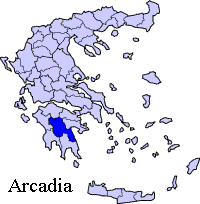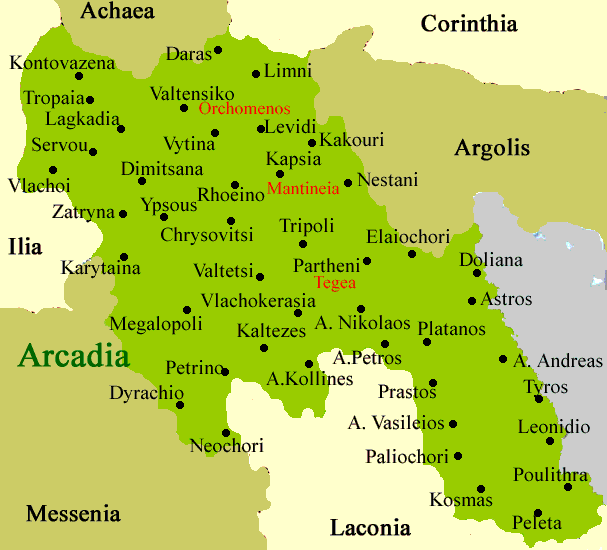|
|
Leonidio municipality, Arcadia, Satellite image Landscape Leonidio, with a population of 6,294 (according to the 2001 census), emerges from a spectacular landscape, bound by two abrupt mountainsides enclosing the town from the north and south. The River Dafnon passes through the town, and its banks are linked with three bridges. The town is capital of the Tsakonia region, notable for its cultural and linguistic particularities, and the settlement itself offers striking and picturesque architecture; now a protected architectural site, there are very strict regulations for building within the town's limits. Plaka Plaka is the picturesque port of Leonidio, situated 4km from the town. It functions mainly with the help of tourism (gas and water are supplied), but a small fishing fleet is also to be found; a well-regarded beach lies 4km across the shore. The port takes in a number of taverns and bars immediately adjacent to the sea, while every August, it also hosts the "Tsakonian Eggplant Festival", attracting well-known chefs from across Europe and achieving ever-growing popularity. History Leonidio is situated near the ancient city of Prasiae, which was an important harbour for Sparta until its ruin by the Athenians during the Peloponnesian War. The ancient Greek traveller Pausanias describes the area as the "garden of Dionysus", because of the fertility of its plain, and in ancient myth the young Dionysus was found on its beach and later brought up in a cave emerging from it. There is also a second variant of the story, influenced by Christian tradition, recounting the finding of the relics of Saint Leonides atop the beach of Leonidio, where a church was to be built in his honour, remaining to this day; this is a common suggestion for the derivation of the area's name. During the Middle Ages, Leonidio found itself used only as a winter refuge for the inhabitants of Prastos, the former capital of Tsakonia. When Prastos was burned to the ground by Ibrahim Pasha during the Greek Revolution, however, its refugees found shelter in Leonidio, protected by the morphology of the landscape. In ensuing years the town flourished and thrived, counting among its residents wealthy merchants and seamen, closely associated with Constantinople and Odessa; during this period beautiful neo-classical house and tower house structures were built within its limits, including the "Tsikaliotis Tower". On January 21, 1949, a major battle of the Greek civil war took place here. Modern Era Today, Leonidio is a lively and colourful town, especially in summer months, as a result of newly developing tourism. Agriculture, nevertheless, remains a main source of income for its residents, and the benefits of the exploitation of the plain are irreplaceable. The town is also famous for its unusual Easter celebration, when the custom of aerostata ("air balloons") attracts spectators; the well-known Greek comedy writer Dimitrios Psathas once recommended the virtues of passing: "..carnival in Patras, and Easters in Leonidio". Geography The municipality is situated on the eastern coast of the Peloponnese and, although coastal, opening on to the Myrtoon Sea, it is also mainly mountainous, punctuated by the Parnon. Leonidio town itself, however, is to be found on the areas's plain, which proves fertile and very important for the local economy, with its high level of agricultural employment. Apart from citrus fruit, tomatoes and olives, the area's most famous and widely-distributed product is the Tsakonian eggplant, characteristic in its sweet taste, and acknowledged and protected by the European Union. Geology Thanks to its position on the mountain of Parnon, the Leonidio municipality is home to a number of stunning geological formations, such as the Peleta Sinkhole, and the Propantes pothole (a vertical cave). Demographics Newly developing tourism is also a vital part of the area, with its scenic, clean beaches and breathtaking mountain scenery. Notably, the area is part of Tsakonia, and the Tsakonian language is still spoken in some areas. Its municipal departments take in the following: Leonidio, Ag. Vasilis, Kounoupia, Mari, Paliohori, Peleta, Pigadi, Platanaki, Poulithra, Pragmatefti, Tsitalia, and Vlisidia. Division of the municipality (Δ.δ. : municipal department)
Monastery Agiou Nikolaou Sintzas,
"Our language is Tsakonian", bilingual (Tsakonian and Standard Greek) sign in Leonidio Easter in Leonidio, hot air balloons in the sky Leonidio is a small city, named after the Saint Leonidis. His body was found in a shore which is around 4 km from Leonidio. Leonidio is known from the special Aubergine produced in the region the Tsakoniki Melintzana Leonidiou In August there is a festival of the Aubergine and a contest of the best recipes using the Aubergine of Leonidion.
Retrieved from "http://en.wikipedia.org/"
 |
||||||||||||||







